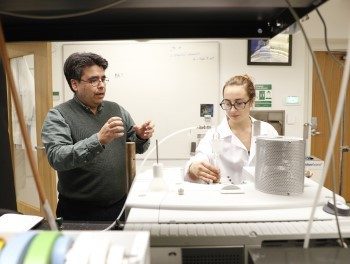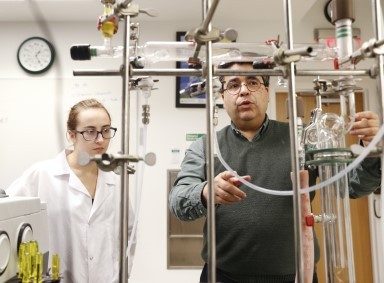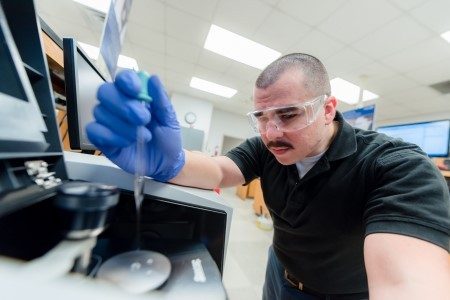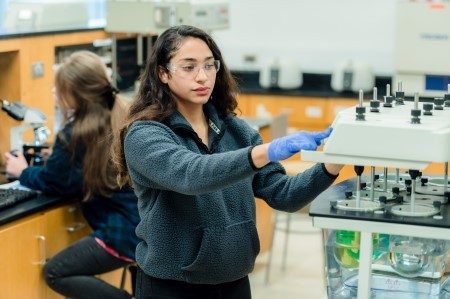Institutional Highlight: A Hands-On Environment Creates Tomorrow’s Best Chemists
Here, two experts explain how they develop technology-trained leaders of the future.
by Mike May for the American Chemical Society
A favorable learning environment can trigger curiosity that stays with students for a lifetime. Here, we explore how students learn about chemistry in two beautiful areas of the United States.
In the foothills of the Adirondack mountains, Saratoga Springs, NY, is home to mineral springs and Skidmore College. At this four-year school, 40% of its chemistry majors go on to graduate programs. The desire to explore chemistry more deeply arises in part from dedication to research among the faculty, which is passed on to the students.
“This department takes seriously the teacher-scholar model,” says Juan Navea—a physical chemist who studies atmospheric chemistry and is a professor of chemistry and chair of Skidmore’s chemistry department. The wider community even acknowledges Skidmore’s success in its teacher-scholar model. In 2020, Navea received a Henry Dreyfus Teacher-Scholar Award, which includes a $75,ooo research grant. He points out that this award arose from a team effort. “I would not have had a shot at this award if it was not for the department’s philosophy of bringing students into research as part of their identity—not research as an isolated item,” he says. “Here, research is incorporated into our teaching effort.”
That effort starts early for chemistry students at Skidmore. “Our curriculum encourages students really early on to explore, and having our program approved by the American Chemical Society helps us maintain the necessary rigor,” Navea says. That rigor includes a range of research opportunities for students. “We encourage students to explore research, fostering curiosity through research,” Navea says. For example, Skidmore’s chemistry department arranges research open houses. “Every faculty member has an elevator pitch about their work,” Navea explains. “After hearing from each faculty member, students can engage in conversations with our current students working with faculty members.” From these interactions, students can pick a lab where they can work on a research project.


For instance, Navea says, “I have a team of students who engage in different projects, and students can become the leaders of a research project.” Some of the students make presentations at conferences and even participate in writing a paper about the work.
The faculty members at Skidmore also seek and secure funding for research projects. Currently, the chemistry department has four grants from the National Science Foundation (NSF). As Navea describes that: “We’ve been incredibly successful in securing federal grants.” In addition, the chemistry faculty at Skidmore successfully publish their work. “We have a great publication rate, Navea says. As an example, his research group, publishes about 2.5 papers a year.
Chemical research for students and faculty depends on advanced instrumentation. In addition to obtaining the equipment, it also requires maintenance. “We have a PhD in analytical chemistry who oversees and coordinates our instrumentation, and trains students to use it,” Navea explains. “So, we have someone dedicated to maintaining our equipment, and I don’t have to explain to anyone how important that is.”
From teaching to research, Navea says that the department’s ACS certification makes life easier. “The ACS certification and all the processes make a holistic major,” he says. “Following the ACS guidelines and having approval is important for the college, and it helps us justify faculty lines to teach certain courses.” He adds that ACS certification also helps the department add electives, like computational chemistry or nanoscience. “It’s not something that ACS does directly, but it’s easier for us to explain what we have to cover to non-chemists who might be at the head of an institution,” he says.
Skidmore’s chemistry department also takes advantage of ACS sponsored events. “We take students to regional and national ACS meetings,” Navea says. “The students get to talk with scientists and graduate students from other institutions—getting information, exploring the whole environment that is generated in an ACS meeting.” Although chemistry students at Skidmore get these opportunities, Navea would like to see travel grants to make such experiences possible for students from other liberal-arts colleges.
“Research opportunities give students a better sense of what chemistry is all about,” he says. “They might find that chemical research is their calling or they might discover other exciting things about themselves.”
Creating a community of opportunities
Near the waterfront of the Cape Fear River in Wilmington, NC, students prepare for a wide variety of career paths at Cape Fear Community College. “Our two-year AAS degree provides training to students who wish to work in fields related to the laboratory sciences,” says Tracy Holbrook, program director of chemical technology at Cape Fear Community College. “Graduates find themselves working for pharmaceutical, environmental, forensics, cosmetics, food and beverage, quality control, production, and manufacturing companies.” The potential jobs for Cape Fear’s chemical-technology graduates include laboratory technicians, entry-level chemists, metrologists, sales representatives, quality-control reviewers, and many other roles. As Holbrook says, “As the program director, it is my responsibility to ensure that the program stays in constant contact with employers and ensure that we adapt and change our curriculum, as needed, to meet their needs.”
When asked what makes Holbrook proud of the department, he says, “I am especially proud of our graduates.” He adds, “They take pride in the education and training that they have received and represent the program, our faculty, and the college exceptionally well.” In fact, as the only chemical technology program in North Carolina, Holbrook says, “it’s not uncommon for our graduates to be selected for job opportunities over BS chemistry candidates.”
Part of the appeal of Cape Fear’s chemical-technology graduates comes from their training on a variety of instruments. “While theory is important to our program, we place a focus on hands-on activities blended with real-world scenarios,” Holbrook explains. “Students prepare their own samples, use analytical instrumentation and software to process their samples, and perform all data analysis themselves.” The instrument training covers a range of techniques: HS-GC-FID, GC-TCD, GCMS, FTIR, HPLC, IC, TLC, UV/Vis, AA/AE, TOC, KF titrators, automated polarimeters, density meters, refractometers, and many other techniques, such as Kjeldahl, Soxhlet, Monier-Williams, and fractionation.


Cape Fear's students working in laboratory.
Some of the opportunities at Cape Fear arise from NSF support. “Recently, with the help of the NSF, our program created a work-based learning opportunity for students involving a local pharmaceutical company, Quality Chemical Laboratories,” Holbrook says. “For two semesters, students work with company trainers and are introduced to various procedures on raw-material testing and finished products.” As a result, many of those students are hired before they graduate from Cape Fear’s program.
Holbrook and his colleagues also reach out to the local community. “We perform outreach activities that include high school students and teachers,” he says. “Both cohorts visit the college campus, learn more about the field of chemical technology, and are provided training on analytical instrumentation.”
Outreach from ACS could also benefit programs like Cape Fear’s. “ACS should continue to represent two-year programs at community colleges and provide resources for chemical technology departments, such as ours,” Holbrook says. “While many community college students transfer to four-year colleges or universities, programs like the AAS in chemical technology can directly impact today’s workforce and help satisfy the needs of employers by producing graduates who are ready for the workforce.” He adds, “Some students decide to further their degrees, but many students have the opportunity to begin careers right away.”
The environment created for chemistry students at all schools lays the foundation for their careers and supports society in many ways.
“I am especially proud of our graduates. They take pride in the education and training that they have received and represent the program, our faculty, and the college exceptionally well.” Tracy Holbrook, PhD, Cape Fear's Community College.

